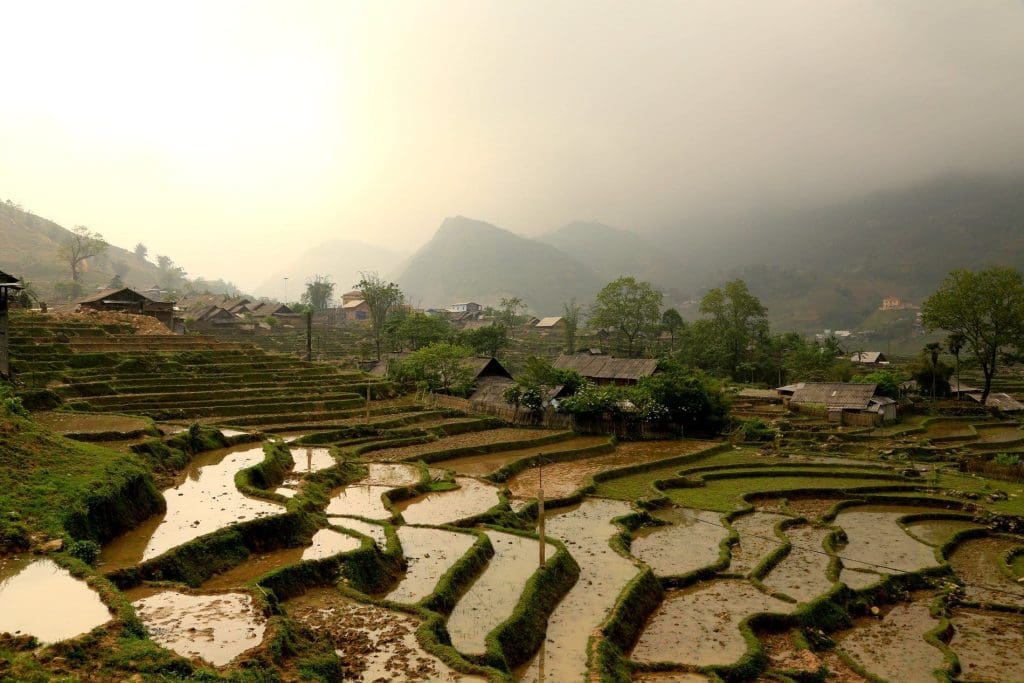On a trip to the north of Vietnam, Joe Ogden travels by train, junk boat and on foot to capture this collection of photos as he travels from the streets of Hanoi to Sapa rice terraces and the enchanting Halong Bay.
Hanoi and its Old Quarter
There’s no doubt that the city of Hanoi is an attractive capital. The wide range of architectural styles span centuries from the ancient Oriental styles of the Old Quarter, to a heavy Art Deco influence from the French colonial era, and the later Brutalist styles of post-Imperial, post-Colonial communist Vietnam. The city lends itself to exploration on foot – the small winding streets of the Old Quarter are set between wide boulevards fringed with trees and imposing government buildings. The Old Quarter contains 36 small streets, each famed for a specific trade. Traders would come from around the region to find the artisans in Hanoi producing all manner of crafts.
There are plenty of things to do in Hanoi.
You can explore the many lakes dotted around the city – which contain everything from mystic giant turtles to downed B-52 bombers. The “West Lake” area of town is home to a more modern scene, with flashy hotels, bars and restaurants dotted around its shores.
The war museum is an informative trip through the modern history of Vietnam and the whole Indochina region. The country was in a near constant state of war for decades from the Japanese invasion during World War Two, to the post-war fight for independence from French colonial rule, and of course the Vietnam War, or as they call it here The American War. The Ho Chi Minh Mausoleum and museum is an equally interesting part of the country’s history and is worth a visit.
Autumn and Spring are the best time of year to visit Hanoi, avoiding the hot humid summer rains and cold winter months.
Hanoi to Sapa: The Roof of Indochina
The incredible overnight train journey from Hanoi to Sapa (also spelled “Sa Pa”) takes you high into the mountains near the border with China. After sleeping through the clickety-clack as much as possible, at sunrise you’ll awake surrounded by fresh mountain air and breath-taking scenery – the epitome of the phrase “it’s about the journey, not the destination”.
The town of Sapa lies 1,500 metres above sea level and is still in the shadow of the 3,143m high Mount Fansipan – the tallest mountain in Indochina. The thing to do in Sapa is trekking, so prepare your walking boots for a long hike up and down the valleys and terraced rice fields. The crisp air and cooler temperatures are a welcome relief from the sticky, humid streets of Hanoi.
The best time of year to visit Sapa is in the Spring between February and April, when temperatures are rising but before the May-September rainy season. The winter months can get very cold, with temperatures sometimes dipping below freezing at higher altitudes.

Halong Bay Junk Boat Cruise
The enchanting Halong Bay (also spelled “Ha Long”) with thousands of limestone outcrops is a well-established and very popular tourist destination. A night or two aboard a traditional “junk” boat will allow you to soak up the ambience and explore the islands of the bay in comfort. Despite the large number of visitors there is plenty of space for everyone. As you float peacefully around the bay it’s impossible not to relax. Your boat will likely stop off for visits to caves, kayaking, and walks up the small islands, so there’s plenty to do too.
Halong Bay is 170km east of Hanoi, and takes around three hours by bus or taxi. You can easily arrange transport and a one- or two-night Halong Bay cruise from your hotel or a travel agent in Hanoi.
The climate in Halong Bay is largely the same as Hanoi, so it is best to visit in the spring or autumn months. March to April is the ideal time for a trip around all these three destinations in North Vietnam.
If you have enjoyed Joe’s snapshot of Hanoi to Sapa, then why not cast a glance over his photos of Things to Do in Hue : A Trip Back in Time or Things to Do in Da Nang : Vietnam’s City of Bridges.
Flights to Hanoi
Hanoi has direct flights from many cities worldwide. If travelling to Hanoi from the UK or Europe try Vietnam Airlines or other major carriers like Emirates, Singapore Airlines or Thai Airways. Regional visitors can use the usual low-cost carriers; AirAsia, Lion Air and VietJet. Vietnam Airlines also flies between Hanoi and most major cities in Southeast Asia including Bangkok, Phnom Penh, Vientiane, Kuala Lumpur and Singapore. Sometimes with a transfer in Ho Chi Minh City. Use our comparison engine below to find the best flights to Hanoi. Travelling from Hanoi to Sapa is best done by train.
Hotels in Hanoi
The Old Quarter is the best place to stay if you want to walk around and experience the cultural heritage of Hanoi. Find a small boutique hotel set amidst the small streets. It’s a short walk from here to many of the popular tourist attractions including the museums, temples and the cathedral. For four or five-star hotels you’ll need to look at the West Lake area – unless you opt fro the Sofitel Metropole -, but you would be relying on taxis to get around.
Enter your dates into our hotel and flight comparison engine below to find the best deals for your travel to Vietnam.
Click to search for hotels with AgodaVisas for Vietnam
As of May 2019, visitors from 24 countries currently get visa-free entry to Vietnam for a stay of 15 days or more depending on the country. This includes the UK, most European nations, Southeast Asia, and more. Check the latest travel advice before travelling as the situation does change periodically. UK citizens can find the latest Vietnam visa information here: https://www.gov.uk/foreign-travel-advice/vietnam/entry-requirements
